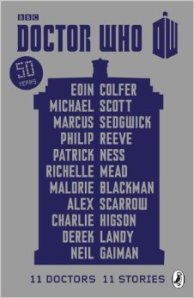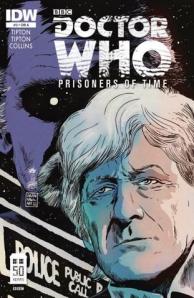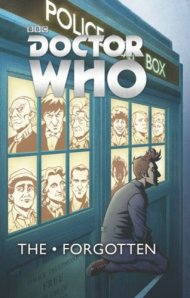As I’ve noted before, I jumped ahead to the most recent Big Finish main range audios to keep up with the current stories, with plans of listening to all the others as I obtain them. For the early stuff, I’m trying to go in order, but then some synopsis captures my attention and I’m off the beaten track again. It doesn’t help that I’m buying them out of order. Anyway, I recently listened to “Masquerade” and “Breaking Bubbles and Other Stories”, and here’s my thoughts on them.
Spoilers of course. Always spoilers.
 “Masquerade” is the third in a trilogy of Fifth Doctor stories, with Nyssa and Hannah Bartholomew, a new companion that the Doctor first encountered two stories ago. The story begins with the famous “Doctor”, a friend of Voltaire, visiting the estate of the Marquise de Rimdelle in 1770 France. The Doctor’s niece Nyssa senses the presence of something out in the fog, something she calls the Steamroller Man. And there’s a dead man in the cellar who tells the Doctor that the Steamroller Man is coming to smash the manor and kill everyone. Now, you can’t listen to a story set up like and not know that something odd is going on. It turns out that this is a computer simulation-type thing created by human scientists who are trying to work on a way for humans to survive long space trips, such as colonization trips to new star systems. Something’s gone wrong with it this time, though, and they soon find out that it’s been co-opted by a group of alien races who had been displaced by human colonization and are trying to get revenge and trying to stop human expansion. They plan to use the simulation to destroy the humans, first here, then on Earth. (It’s a bit too involved to explain how this would happen.)
“Masquerade” is the third in a trilogy of Fifth Doctor stories, with Nyssa and Hannah Bartholomew, a new companion that the Doctor first encountered two stories ago. The story begins with the famous “Doctor”, a friend of Voltaire, visiting the estate of the Marquise de Rimdelle in 1770 France. The Doctor’s niece Nyssa senses the presence of something out in the fog, something she calls the Steamroller Man. And there’s a dead man in the cellar who tells the Doctor that the Steamroller Man is coming to smash the manor and kill everyone. Now, you can’t listen to a story set up like and not know that something odd is going on. It turns out that this is a computer simulation-type thing created by human scientists who are trying to work on a way for humans to survive long space trips, such as colonization trips to new star systems. Something’s gone wrong with it this time, though, and they soon find out that it’s been co-opted by a group of alien races who had been displaced by human colonization and are trying to get revenge and trying to stop human expansion. They plan to use the simulation to destroy the humans, first here, then on Earth. (It’s a bit too involved to explain how this would happen.)
I will admit I wasn’t giving the audio my full attention (I was playing Diablo 3 while listening to it), but it really wasn’t very riveting. Though there were a few misleads and cliffhangers along the way, it was pretty straightforward. Nyssa was very important during it, trying to counsel the scientists as they came to grips with the things that were happening to them. I think the thing that I didn’t like about the play was that I felt no sympathy towards the aliens. They were right to be angry about the injustices they had endured at the hands of the humans, but they were otherwise unreasonable and single-minded. It would have been a far better story if it had emphasized the moral conflict the Doctor would have when considering both sides of the story, but that was more or less ignored. The ending of the story and the departure of Hannah, however, was very well done and quite emotional.
 “Breaking Bubbles and Other Stories” is a series of four short plays, “Breaking Bubbles”, “Of Chaos Time The”, “An Eye for Murder”, and “The Curious Incident of the Doctor in the Night-Time”, featuring the Sixth Doctor and Peri. I’ve only listened to two anthologies of shorts so far, this one and “Circular Time“, and so far I’ve enjoyed both of them quite a bit. Part of it is that it’s nice to have bite-sized chunks of the Doctor to enjoy every so often. But I do think that both of these anthologies have had a couple of exceptional tales.
“Breaking Bubbles and Other Stories” is a series of four short plays, “Breaking Bubbles”, “Of Chaos Time The”, “An Eye for Murder”, and “The Curious Incident of the Doctor in the Night-Time”, featuring the Sixth Doctor and Peri. I’ve only listened to two anthologies of shorts so far, this one and “Circular Time“, and so far I’ve enjoyed both of them quite a bit. Part of it is that it’s nice to have bite-sized chunks of the Doctor to enjoy every so often. But I do think that both of these anthologies have had a couple of exceptional tales.
“Breaking Bubbles” and “An Eye for Murder” were good stories. In the first, the Doctor and Peri find themselves in the garden of Empress Safira Valtris, and they soon find that she’s actually a deposed empress, living on a prison ship. Because she’s royalty, she can’t be harmed (assassinated or executed), so she lives in what’s basically a holodeck, giving her the comforts of royal life. Her captors immediately take the TARDIS crew prisoner, as they assume they’re here to help Safira escape. Well, the empress is trying to escape, and she does nearly do so, but when things go awry, it becomes apparent that her planned bloodless escape is about to turn very bloody, and the Doctor convinces her that this is not the way she wants it. In the second, Peri is mistaken for a mystery writer and is co-opted to find the author of threatening letters at a women’s college in England on the eve of World War II. Among the faculty is at least one Communist sympathizer and a Nazi sympathizer. This was probably the weakest of the stories in the set, dealing with the politics within the college. There was an alien threat, too, but the focus of the story was on the faculty.
You can probably tell that “Of Chaos Time The” is an unusual story from its title. It starts out with the Doctor wondering where he is, why he’s there, and who the person with him is. It’s not that he’s woken up in a strange place: he’s on his feet, running down a corridor with a person he doesn’t know, and that person is obviously following his instructions. He then finds himself in a completely different situation, again with another person he doesn’t know. As the story proceeds, he finds that he’s jumping in time, within one length of time in his life, going in random order through a series of event that Peri and everyone else is experiencing normally. As he’s going through things in the wrong order, he has to figure out what’s going on, why it’s all happening, and how to start it. As the story progresses (and I’m not going to divulge the story, because this is a great one to listen to without spoilers), he inevitably sees later parts of the story and figures out what he needs to do in earlier parts to both make the later parts happen as he saw them and solve the situation. The base story is interesting in itself, though nothing particularly memorable; it’s the time jumping that makes it wonderful. This story is a masterpiece of temporal trickery.
The final story, “The Curious Incident of the Doctor in the Night-Time”, is remarkable because of how it was presented, and it was easily the story I enjoyed the most. The main character in this one is a boy, Michael, and he’s also the narrator for most of it. He’s making an audio diary of the events that happened to him, and from the beginning, it’s obvious he’s autistic, and his observations and thoughts about the things that happened are striking. His father, a hardware/garden store worker, loses his job and blames Michael, because he thinks Michael told his boss that his father had stolen his collection of 129 garden gnomes from work, and later that day, his father gets killed while fishing to let off steam. Michael, however, notices that there are now 130 garden gnomes and realizes something is wrong. He goes to investigate, and this is how he meets the Doctor, who is also investigating the gnomes. In true Doctor Who style, it turns out that the gnomes are actually malicious aliens who had been frozen on Earth to lock them away from the rest of the universe, and the 130th gnome was there to release them and destroy the planet.
The real story here, though, is Michael’s journey through the story, dealing with his disability and with his father’s death (which he is unable to understand for quite a while, and then unable to accept when he finally does understand). I’ll admit that I don’t know much about autism, but at least in my opinion, the portrayal of the character and his difficulties was beautiful. I would recommend getting this audio release for this story alone. It’s that good.
And that’s the main range for now. Next time, I’ll be switching gears a little, because I just received in the mail the set of CDs I’ve been waiting for: the Gallifrey range. I’m eager to hear more of Romana and Leela, and finally meet Narvin and Braxiatel.




